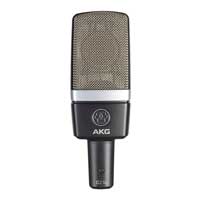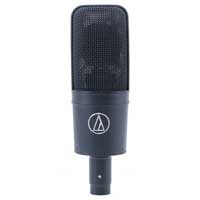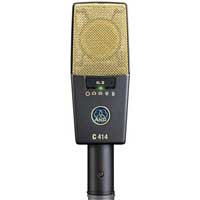Summary and Rating: AKG C214 Review
AKG C214
Our Overall Rating
4.7 (out of 5)
Specs:
- Pick-up pattern: Cardioid (20 Hz – 20 kHz)
- Self-noise: 13 dB(A)
- Attenuation Pad: -20 dB
- Bass-cut Filter: 160Hz
- Max SPL: 136 dB
- Weight: 280 g
Pros
Pros AKG C214
- Overall reliable, refined sound
- Captures transient details very well for a mic in its class
- Handles vocal sibilance and plosives with ease
- Comes with shockmount, pop filter and steel carry case.
Cons
Cons AKG C214
- It will disappoint you if you’re expecting it to sound like a C414
- Unnatural boost in the high frequencies annoys some
Bottom Line
A well-built, affordable condenser that performs well in most recording applications. Good for vocals, acoustic guitars, amps and drum kits. A definite front-runner in the crowded market at this price range.
Check Availability and Price in Your Region:
US and Canada
UK and Europe
A Mic in its Own Right
AKG markets this large-diaphragm FET condenser mic as a lower-cost alternative to the famous C414 (essentially a 414 without the switchable polar pattern).
This is misleading, however, as the C214 is a different mic altogether – a great value microphone in its own right. We test it out below so you can hear the results with your own ears.
For more microphone reviews, see our gear category page.
What’s in the box?
The C214 comes with a lovely hardshell carry case, an AKG H85 shockmount (fitting most mics with a shaft diameter between 19 and 26mm), and a sock-style foam pop-filter.
Who is this mic for?
If you’re looking for a quality studio condenser microphone that excels at vocals, acoustic stringed instruments, guitar amps, and drum kit recording, this is without a doubt, a front-runner in the crowded market of mics in this price range.
Who is this mic NOT for?
This mic is NOT suited for the following situations:
- Untreated, noisy environments
- Live applications (A dynamic mic like the Sennheiser e935 or the Shure SM57 would be recommended in this case. If you’re looking for a live condenser, the Sennheiser e965 would be our recommendation.)
- Mid-side techniques, or other applications that require switchable polar patterns other than cardioid.
Build / Design
The C214, first released in 2008, was designed and manufactured by AKG in Vienna, Austria. This places the C214 more in the elite family of AKG as this is where all the higher-end AKG mics are made. In contrast, the P-series mics are all manufactured in China.
It comes with two switches on the sides of the housing: a 20dB attenuation pad and a bass-cut filter.
The C214 capsule looks like the C414 but is in fact a back-electret design, our first hint that this mic was perhaps not simply a cardioid-only 414. (See ‘what is an electret condenser?’ in the FAQ below)
If I’m a stickler for design, I prefer the super-square hard angles of the original 414 designs in comparison with this new round-corner C214.
Self-noise and Max SPL
The self-noise on this mic sits at 13 dBA, which more than doubles that of the C414 (at 6dBA). That said, 13dBA is still not high enough to be noticeable in most recording applications.
With a max SPL of 136 dB (156 with the attenuation pad), it can handle the loud stuff without distortion. (unless you plan on recording explosions or rocket launches)
Sound
AKG C214 Frequency Response
As you can see in the frequency response chart, the C214 has a totally different sonic signature to the C414. AKG says that the C214 has a “performance close to the famous C414 XLII”. Without even listening to the results, we can see that that is clearly not the case.
Frequency Response Chart: AKG C214
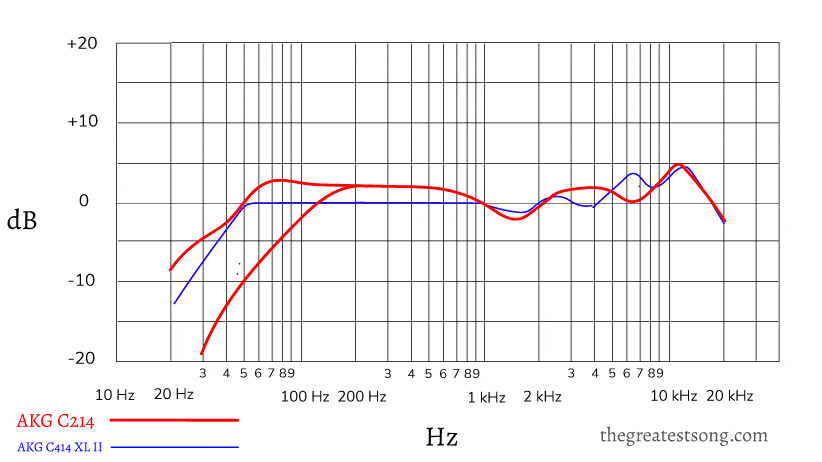
AKG C214: The Test
We used a Universal Audio Apollo Solo Interface recorded with Logic Pro X. There is no EQ or compression applied to any of the audio clips here. We adjusted the gain from the audio interface to taste. The guitars were a Martin steel-string acoustic guitar and Fender Strat plugged into 40 Watt Fender Champ.
Full disclosure: We fully acknowledge that there is no one way to use a microphone. Mic placement, how you play or sing, not to mention EQ, compression, Impedance, and preamp settings can all have dramatic effects on the final result.
Sung Vocals Test
Spoken Vocals Test: Plosives, Sibilance
Acoustic guitar test
Electric Guitar (Clean) Test
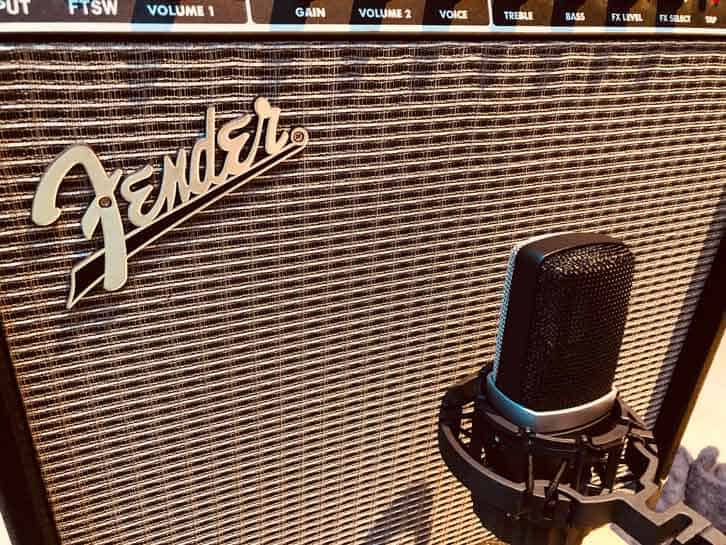
Electric Guitar (Distortion) Test
Conclusions about the Sound
The results of our tests proved this mic to deliver a reliable, refined sound in a wide range of applications.
Comparing the C214’s sound to the sound of the C414 is comparing apples to oranges. I think it is a real mistake on the part of AKG to market this as a ‘low-cost alternative to the C414.’ If you’re expecting a 414 sound, you’ll be disappointed.
The frequency boost in the higher frequencies gives this mic a modern bright sound. It never produced ‘reedy’ or ‘brittle’ results for us, which was the report from some.
Some features of this mics sound that you might want to be aware of are one, its proximity effect is more pronounced than others in its class. And two, the polar pattern has less rear rejection than most cardioid condensers.
As with all vocal recording, you will need to match the voice you’re recording with its ideal microphone. In general, the C214 felt like a very easy mic to sing with. We welcomed its low sibilance relative to some of its competitors.
What they say about the AKG C214
Researching this mic, I asked other sound nerds about their thoughts on the C214. Most were satisfied with this mic, and those who were not satisfied were all expecting ‘a low-cost alternative to the C414’.
Here are some testimonials:
I’ve been using this mic for everything in my studio. I can pretty much make anything sound reasonably good. It has nice presence on vocals and is equally good as a drum overhead.
George Stone, Singer
I didn’t like this mic when I first got it because I thought it would sound like a C414. But with time, I’ve come to appreciate what this thing can do. Of course, the C214 isn’t all things in all applications, but it excels for acoustic guitar, guitar amp, hand percussion, and around a drum kit.
Florian Gröning, Sound Engineer
For all of our microphone trials, click here.
FAQ
Which side is the front?
It comes with a silver side and a black side. The silver side with the AKG logo under it is the front.
Is the AKG C214 Omnidirectional?
No. The C214 has a fixed-polar pattern of cardioid, meaning the focus of the sound picked up by the mic is in front of the mic only.
What is an electret condenser?
For the diaphragm of a condenser mic to be able to sense changes in the sound waves that hit it, it needs a polarised charge.
One of the methods used to apply this charge is to permanently charge the capsule by applying a substance called electret film to the backplate of the mic’s capsule. Hence, we have the term ‘back-electret’.
Are Electret condensers low-quality gear?
There are loads of high-end mics that employ electret condenser technology. So the answer is, no, it doesn’t mean the mic is of lesser quality.
For extensive detail on the topic of choosing a mic, see here.
Questions or Comments?
Join the discussion here on Facebook.
